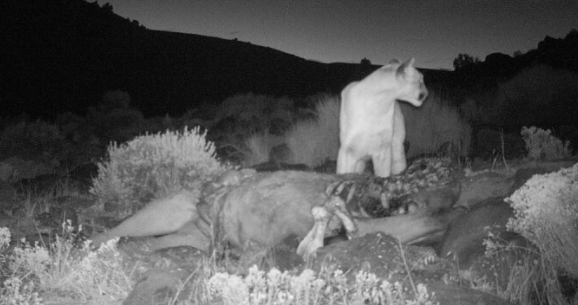
President Teddy Roosevelt called the cougar that “horse-killing cowardly cat.” Though Teddy Roosevelt was a progressive President for his time, I think some of his opinions and attitudes were highly distasteful. He was a war monger and a sadist. He went on a safari to Africa and slaughtered thousands of animals, using the excuse that he was sending specimens back to an American museum. Cougars kill for food, but Roosevelt was slaughtering thousands of animals from a distance with an high-powered rifle under the false guise of obtaining scientific information. I think he did it because he enjoyed being a bloodthirsty killer. I respect the bravery of a cougar far more than anything Roosevelt ever did as an outdoorsman. Cougars are 1 of the few solitary carnivores that regularly attack prey larger than themselves.
There is no doubt cougars kill horses, but Steve Rinella, a Trumpanzee with an hunting and fishing show on the Outdoor Network, disputed a New York Times column written by Dave Phillipps, suggesting cougars could control feral horse populations. Phillips refused to appear on Rinella’s podcast, and Rinella seemed to relish how another expert had proven the author of the column wrong. He’s not wrong. A recent study determined cougars could control feral horse populations in sagebrush environments. Scientists studied 21 radio-collared cougars–13 in the Great Basin region of Nevada and 8 on the Sierra Nevada range. They counted 820 predation events and learned that in the Great Basin region horses made up 60% of the cougars’ diet while mule deer just made up 29% of their diet. On the Sierra Nevada range, mule deer made up 91% of their diet. Cougars hunted horses in sagebrush environments quite often, but rarely in mountain environments. In the Great Basin individual cougars killed an horse about once every 2.5 weeks. Another study looked at cougar prey on the Pryor Mountains. Here, cougars killed no horses and their primary prey was mule deer, though bighorn sheep made up 9% of their prey. 1 individual female cougar specialized in preying upon bighorn sheep, but most cougars preferred deer. I think horses are not an important part of the cougar diet in the Pryor Mountains because there are less than 200 of them there, and they are located in an area with no cougars.
Of course, cougars hunt horses. During the Pleistocene cougars co-existed with horses over the span of 2 continents for hundreds of thousands of years. I’m sure there were certain ancient environments where horses were the most available prey species. Horses are well adapted to arid grasslands, and during the Pleistocene were more common than deer in this type of environment. Cougars would have been competing with dire wolves, giant lions, and saber-tooths in open areas, and they likely were more common in woodlands or forest edges. But they may have held their own in some locations where horses and competing carnivores were abundant, depending upon ecological conditions. Incidentally, the Pleistocene cougars that lived in North America were not directly ancestral to cougars that live on this continent now. They were an extinct ecomorph that grew slightly larger than modern cougars and may have had spotted fur. According to genetic evidence, all modern North American cougars descend from a population originating in eastern South America about 10,000 years ago. Strange as it may seem, this population completely replaced the Pleistocene ecomorph.
Horses originated in North America and lived here for millions of years, until man wiped them out. People who claim feral horses harm the environment are full of shit. Horses make trails, defecate all over the place, and graze down vegetation…just like they did for millions of years. Horses recolonized North America, and this recolonization is no different from when wildlife managers re-introduce endangered species to lands where they had previously disappeared. There are only about 83,000 feral horses in North America today compared to tens of millions of cattle, yet cattle ranchers and do-gooder environmentalists would dishonestly lead people to believe horses are the problem, not the cattle. I call bullshit.
References:
Blake, L.
“Foraging Ecology of Cougars on the Pryor Mountains of Wyoming and Montana”
Utah State Graduate Thesis 2014
Andreason, A.; K. Stewart, W. Longled, J. Berkman
“Prey Specialization in Cougars on Feral Horses in a Desert Environment”
Journal of Wildlife Management July 2021
